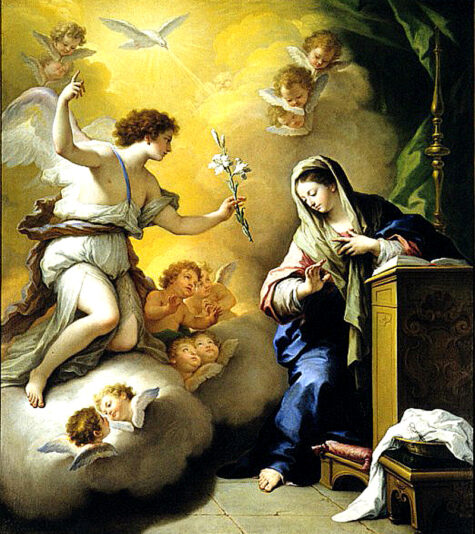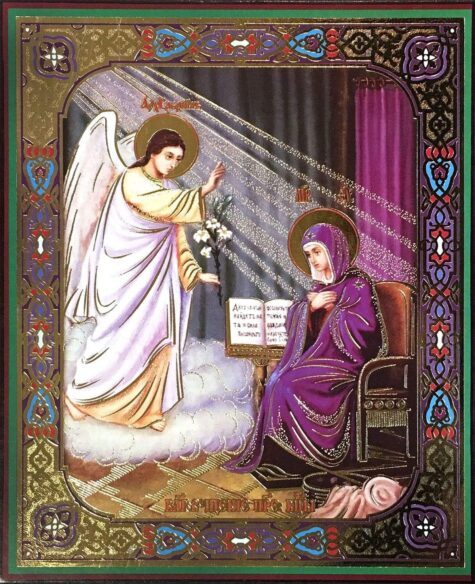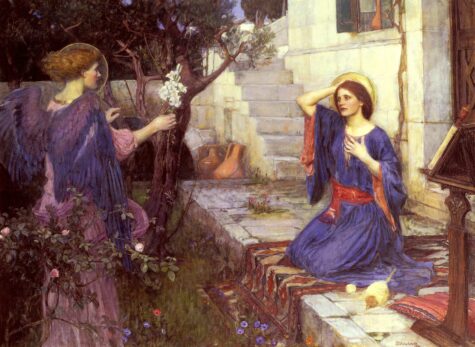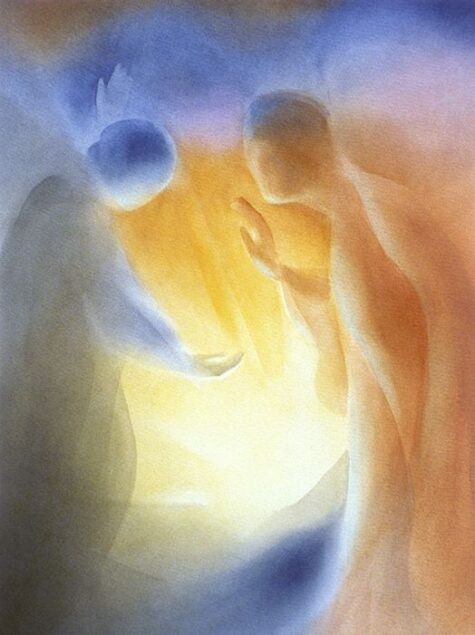The precession of the equinoxes has moved the astronomical beginning of spring back four days to March 21, but its previous date of March 25 became identified with the Virgin Mary, who was told by the angel Gabriel on that day that she would become the mother of Christ.
Lady Day, as this day was commonly called, was one of the great quarterly dividing points of the year (the others being Midsummer Day, Michaelmas, and Christmas). It was traditionally the day for paying rents, signing or vacating leases, and hiring farm laborers for the year.
The flower cardamine, or lady’s-smock, with its milky white flowers, is dedicated to the Virgin Mary and appears about this time.
The Christian New Year’s Day
For centuries the Solemnity of the Annunciation on March 25, not Jan. 1, marked the first day of the New Year.
“Happy New Year!” is what we would have celebrated along with the Feast of the Annunciation on March 25 if we were living some centuries ago. Back then, the Annunciation also marked the start of the New Year.
The choice was well thought out and gives us lots to contemplate. Let’s begin at this point: when reforming the calendar in 45 B.C., Julius Caesar made Jan. 1 New Year’s Day. Celebrated with non-Christian festivities, of course.
Naturally, after Jesus life, death and resurrection, the Christians wanted to celebrate New Year’s Day in a spiritual way.
One early thought was to begin the year in springtime, a natural “new beginning.” And around the time of his Resurrection. According to the Catholic Encyclopedia, what also came into play was the Jewish month of Nisan, which coincides with March and April on the Julian and Gregorian calendars and opens the sacred year.
But then arose the question, on which day should the New Year begin for Christians?
That answer really narrowed down when in the sixth century there came along the monk and abbot named Dionysius Exiguus, who lived in Rome. His name isn’t familiar today, but his work certainly is, especially in the use of B.C. and A.D. He established this way of dating from the birth of Jesus Christ — Before Christ and Anno Domini (the Year of Our Lord). Dionysius wanted to start the Christian era in order to reform the Roman calendar and way of calculating events. One of his great concerns was coming up with the date of Easter.
Naturally, the first day of the New Year had to fit somewhere in the new calendar. But where?
“Since March 25 was calculated as the date of the crucifixion of Jesus, there was a belief that one died on the same day that one was conceived,” writes Father John Fields, vice chancellor and director of communications for the Ukrainian Catholic Archeparchy of Philadelphia. “If Jesus died on March 25 — the 14th of Nisan — then he was also conceived on the 14th of Nisan — March 25.” The date we celebrate the Annunciation. And the Incarnation.
But everyone didn’t adopt it immediately because the Julian calendar was still in widespread use. Besides, here and there in Europe, at times Dec. 25, the Nativity, was being celebrated as New Year’s.
Then along came the Council of Tours which in A.D. 567, put an end to Jan. 1 as New Year’s Day and adopted March 25 as the official first day of the New Year. Soon, yet slowly, countries in Europe were using that date to begin the official New Year. By the 8th century England had adopted this way of reckoning the year. The Catholic Encyclopedia notes that Charlemagne is believed to be the first Christian sovereign to use it.
Father Fields and other sources also point out that March 25 also had other implications. There was a general belief coming from early martyrologies and the early Church Fathers’ writings that March 25 was also the date on which Adam was created and which marked his fall, as well as other major events — the fall of Lucifer; Moses and the Israelites flight through the Red Sea; and Isaac offered in sacrifice by Abraham.
In 1582, along came Pope Gregory XIII who reformed the calendar. Doing so, for the calendar we now use, he placed New Year’s Day, the first day of the year, back to January 1. As he reformed the liturgical calendar also this became the Feast of the Circumcision.
But the Protestant countries weren’t so fast accepting the new Gregorian calendar. The British Empire continued to celebrate New Year’s Day on March 25 until finally adopting the Gregorian calendar on January 1, 1752.
“Until 1751, March 25 was also celebrated as New Year’s Day in the American colonies, since they were under British rule,” adds Father Fields.
Is March 25 still celebrated anywhere as New Year’s Day?
It sure is. In Tuscany in Italy. This year marks the 270th anniversary of the city of Pisa celebrating New Year’s Day on March 25. Florence does likewise (both celebrate the “other” New Year too). The event, begun in 1749, is quite colorful with concerts and festivals. Pisa has a procession to Pisa Cathedral which is dedicated to the Blessed Mother, while in Florence a local pilgrimage proceeds to the Basilica dell’Annunciazione.
So this March 25, the Feast of the Annunciation, remember that for centuries this feast day was the Christian New Year’s Day.
On March 25, instead of thinking of a weepy Auld Lang Syne sort of song, pray or recite with the greatest of joy the Magnificat. For through the Annunciation and Mary’s Fiat, Our Lord Jesus was incarnated and then crucified for our redemption. Now that’s something to really wish someone a Happy New Year about!
God Becomes A Man
The central focus of the Annunciation is Incarnation: God has become one of us. From all eternity God had decided that the Second Person of the Blessed Trinity should become human.
Now the decision is being realized. The God-Man embraces all humanity, indeed all creation, to bring it to God in one great act of love. Because human beings have rejected God, Jesus will accept a life of suffering and an agonizing death.
Mary has an important role to play in God’s plan. From all eternity, God destined her to be the mother of Jesus and closely related to him in the creation and redemption of the world. We could say that God’s decrees of creation and redemption are joined in the decree of Incarnation.
Because Mary is God’s instrument in the Incarnation, she has a role to play with Jesus in creation and redemption. It is a God-given role. It is God’s grace from beginning to end. Mary becomes the eminent figure she is only by God’s grace. She is the empty space where God could act. Everything she is she owes to the Trinity.
Together with Jesus, Mary is the link between heaven and earth. She is the human being who best, after Jesus, exemplifies the possibilities of human existence. She received into her lowliness the infinite love of God. She shows how an ordinary human being can reflect God in the ordinary circumstances of life. She exemplifies what the Church and every member of the Church is meant to become. She is the ultimate product of the creative and redemptive power of God. She manifests what the Incarnation is meant to accomplish for all of us.
Sometimes spiritual writers are accused of putting Mary on a pedestal and thereby, discouraging ordinary humans from imitating her. Perhaps such an observation is misguided. God did put Mary on a pedestal and has put all human beings on a pedestal. We have scarcely begun to realize the magnificence of divine grace, the wonder of God’s freely given love. The marvel of Mary—even in the midst of her very ordinary life—is God’s shout to us to wake up to the marvelous creatures that we all are by divine design.
Sources:
Krazelna: Day of Hekate
Krazelna: Day of Hekate
Krazelna: Day of Hekate
Rachel V Perry: Emancipation Day
Rachel: The Nemesia








Leave a Reply